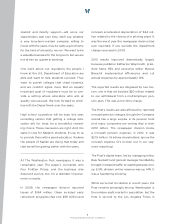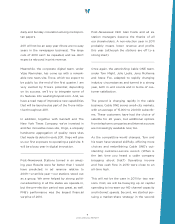Washington Post 2010 Annual Report Download - page 20
Download and view the complete annual report
Please find page 20 of the 2010 Washington Post annual report below. You can navigate through the pages in the report by either clicking on the pages listed below, or by using the keyword search tool below to find specific information within the annual report.effective with the calculation of institutions’ cohort default rates for the federal fiscal year ending September 30, 2009;
those rates are expected to be calculated and issued by the Department of Education in 2012. The Department of
Education will not impose sanctions based on rates calculated under this new methodology until three consecutive years
of rates have been calculated, which is expected to occur in 2014. Until that time, the Department of Education will
continue to calculate rates under the old method and impose sanctions based on those rates. The revised law also
increases the threshold for ending an institution’s participation in certain Title IV programs from 25% to 30% for three
consecutive years, effective for three-year cohort default rates issued beginning in fiscal year 2012. The revised law
changes the threshold for placement on provisional certification to 30% for two of the three most recent fiscal years for
which the Department of Education has published official three-year cohort default rates.
The two-year cohort default rate for Kaplan University (which comprises 52% of Kaplan Higher Education’s revenue) for
the federal fiscal year periods 2008, 2007 and 2006 were 17.2%, 13.3% and 9.2%, respectively. The cohort default
rates for the remaining Kaplan Higher Education reporting units for those federal fiscal year periods ranged from 5.8% to
25.7%, 7.8% to 28.7%, and 2.1% to 24.9%, respectively.
For the 2008 cohort year, one reporting group had a cohort default rate of 25% or more, but none had two or more
years above 25%. For the 2009 cohort year, which has been issued in draft form by the Department of Education, no
reporting units had a cohort default rate greater than 25%. The Department of Education’s 2009 draft rates indicated that
Kaplan University’s 2009 fiscal year cohort default rate was 17.5% and that the overall rates at Kaplan Higher
Education’s reporting units range between 9.8% and 24.3%. The 2009 draft rates are not final and are subject to
revision.
In December 2009, the Department of Education issued an electronic announcement explaining the future changes to the
methodology for calculating an institution’s cohort default rate based on defaults occurring over a three-year period rather
than a two-year period, and released unofficial trial three-year cohort default rates for the 2005, 2006 and 2007
federal fiscal years. In February 2011, the Department of Education issued an electronic announcement releasing
unofficial trial three-year cohort default rates for the 2008 federal fiscal year.
Under the new methodology, the trial rate for Kaplan University was 30% for the 2008 federal fiscal year. The trial rates
for the remaining Kaplan Higher Education reporting institutions under the new methodology ranged from 17% to 39% for
the 2008 federal fiscal year. The Department of Education stated in its electronic announcements that the publication of
these rates is for informational purposes only and that no sanctions will be imposed based on these rates.
Kaplan believes that student loan default rates tend to correlate directly to a student’s family income levels, such that lower
income students will have higher default rates. Kaplan Higher Education’s student population generally tends to come
from lower income groups than those of other providers of higher education, including other for-profit providers. In
addition, because Kaplan Higher Education receives a significantly lower level of taxpayer-funded grants and subsidies
than community colleges, state schools and not-for-profit schools, Kaplan Higher Education’s schools are more dependent
on tuition, and its students are more dependent on loans.
Kaplan has dedicated resources to help students who are at risk of default. Kaplan personnel contact students and
provide assistance, which includes providing students with specific loan repayment information, lender contact information
and debt counseling. Kaplan has also implemented a financial literacy and counseling program for current students.
However, no assurances can be given that these resources will enable Kaplan’s schools to maintain cohort default rates
below the thresholds for sanctions.
In the fourth quarter of 2010, most programs at Kaplan University and Kaplan Higher Education campuses implemented
the Kaplan Commitment, which requires students to meet certain academic conditions during an introductory period
before they are officially accepted into their programs. The Kaplan Commitment also allows students to withdraw during
an introductory period without incurring any tuition obligation. Kaplan believes that the Kaplan Commitment will help
ensure that its student body is more committed, better academically prepared and more likely to complete their programs.
Because, in Kaplan’s experience, students who withdraw prior to program completion demonstrate a higher loan default
rate than those who continue through to graduation, Kaplan is hopeful that the Kaplan Commitment will also improve
cohort default rates. Although Kaplan has taken the above steps and dedicated resources to mitigate the increased risk of
student loan defaults by its students, there is no guarantee that such efforts will be successful in reducing cohort default
rates.
Recent Rulemaking Initiatives. The Department of Education published two Notices of Proposed Rulemaking (“NPRM”)
in June and July 2010 that proposed new regulations related to 14 “program integrity” topics. The Department of
Education published final regulations on October 29, 2010, addressing each of these topics with the exception of
regulations imposing additional eligibility requirements on educational programs subject to the Department of Education
4THE WASHINGTON POST COMPANY
























